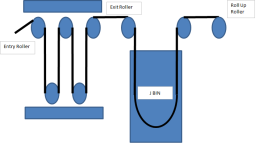JohnDruzianic
Member
Brief Process Description:
Carpet leaves an oven (at approx 2 metres/minute), is pulled into an Accumulator by an Entry Roller. It is pulled out of the
Accumulator by an Exit Roller. From the Exit Roller it spills into a "J Bin". Downstream from the J Bin the carpet is rolled up into carpet rolls for dispatch using the Roll Up Roller.
Carpet travel through the oven must not stop. If carpet is not being rolled up, it will build up in the Accumulator.
The Accumulator comprises two pairs of parallel horizontal beams. Horizontal rollers are fixed between each pair of beams.
Carpet is threaded between the rollers in a zig-zag. The top pair of beams is fixed. The bottom pair of beams will float as the carpet builds up in, or is pulled out of the Accumulator.
The purpose is to control the speed of the Accumulator Exit Roller. A pair of PID instructions will be used.
One for Coarse speed control and one for fine speed control.
The coarse speed is determined by either the Roll Up roller (if carpet is being rolled up) or the Entry Roller (if carpet is not being rolled up and the Accumulator is sitting on the bottom springs). If the Roll Up roller is stopped and the Accumulator is lifted off the bottom springs, the Exit Roller remains stopped and carpet builds up in the Accumulator until the Accumulator bottom beam rests on the bottom
springs. Then the Exit Roller starts at the same speed as the Entry Roller.
If carpet is being rolled up, the height of the carpet web above the J_Bin is measured and the
Exit Roller speed is adjusted to maintain the height of the web at a set value using the fine PID.
If the speed of the Entry Roller is used for coarse control of the Exit Roller, the speed of the Exit Roller is finely adjusted by measuring the sag of the carpet underneath the first incoming roller of the Accumulator and maintaining that sag using the fine PID.
The Problem:
My problem is that the Exit Roller (in order to keep up with the Roll Up roller) will have to lift
the combined mass of the carpet and the bottom pair of beams (and rollers). At that stage the dymnamics are different
from when the Accumulator bottom beams are resting on the bottom springs.
Should I use the same pair of PID instructions regardless and have the PLC (Schneider Twido) change the Kp, Ki and Kd values
depending on whether the Acuumulator is resting on the bottom springs or has been lifted off the bottom springs ?
OR
Have a separate pair of PID instructions (which have their Kp, Ki and Kd values fixed) to take over control when the Accumulator is lifted of the bottom springs. The non-active pair of PID instructions are set to manual mode and they track the active pair so that bumpless transfer can occur.
Carpet leaves an oven (at approx 2 metres/minute), is pulled into an Accumulator by an Entry Roller. It is pulled out of the
Accumulator by an Exit Roller. From the Exit Roller it spills into a "J Bin". Downstream from the J Bin the carpet is rolled up into carpet rolls for dispatch using the Roll Up Roller.
Carpet travel through the oven must not stop. If carpet is not being rolled up, it will build up in the Accumulator.
The Accumulator comprises two pairs of parallel horizontal beams. Horizontal rollers are fixed between each pair of beams.
Carpet is threaded between the rollers in a zig-zag. The top pair of beams is fixed. The bottom pair of beams will float as the carpet builds up in, or is pulled out of the Accumulator.
The purpose is to control the speed of the Accumulator Exit Roller. A pair of PID instructions will be used.
One for Coarse speed control and one for fine speed control.
The coarse speed is determined by either the Roll Up roller (if carpet is being rolled up) or the Entry Roller (if carpet is not being rolled up and the Accumulator is sitting on the bottom springs). If the Roll Up roller is stopped and the Accumulator is lifted off the bottom springs, the Exit Roller remains stopped and carpet builds up in the Accumulator until the Accumulator bottom beam rests on the bottom
springs. Then the Exit Roller starts at the same speed as the Entry Roller.
If carpet is being rolled up, the height of the carpet web above the J_Bin is measured and the
Exit Roller speed is adjusted to maintain the height of the web at a set value using the fine PID.
If the speed of the Entry Roller is used for coarse control of the Exit Roller, the speed of the Exit Roller is finely adjusted by measuring the sag of the carpet underneath the first incoming roller of the Accumulator and maintaining that sag using the fine PID.
The Problem:
My problem is that the Exit Roller (in order to keep up with the Roll Up roller) will have to lift
the combined mass of the carpet and the bottom pair of beams (and rollers). At that stage the dymnamics are different
from when the Accumulator bottom beams are resting on the bottom springs.
Should I use the same pair of PID instructions regardless and have the PLC (Schneider Twido) change the Kp, Ki and Kd values
depending on whether the Acuumulator is resting on the bottom springs or has been lifted off the bottom springs ?
OR
Have a separate pair of PID instructions (which have their Kp, Ki and Kd values fixed) to take over control when the Accumulator is lifted of the bottom springs. The non-active pair of PID instructions are set to manual mode and they track the active pair so that bumpless transfer can occur.








